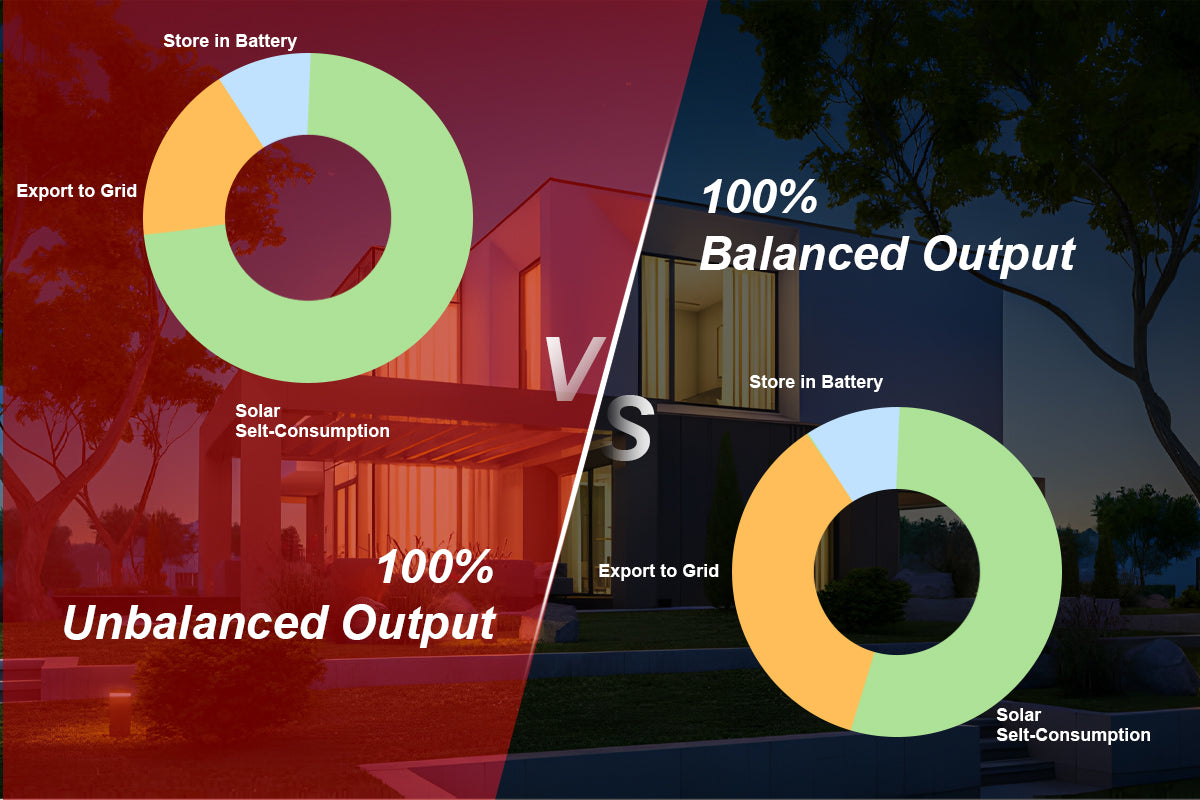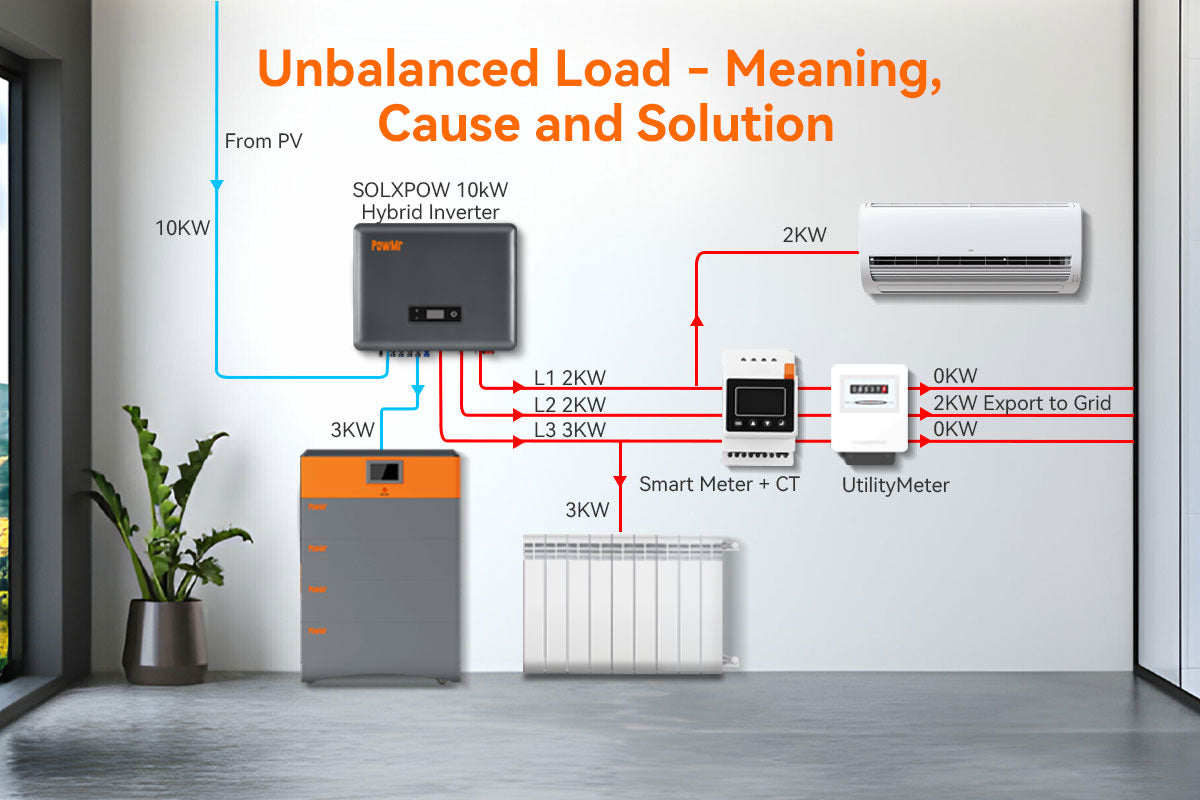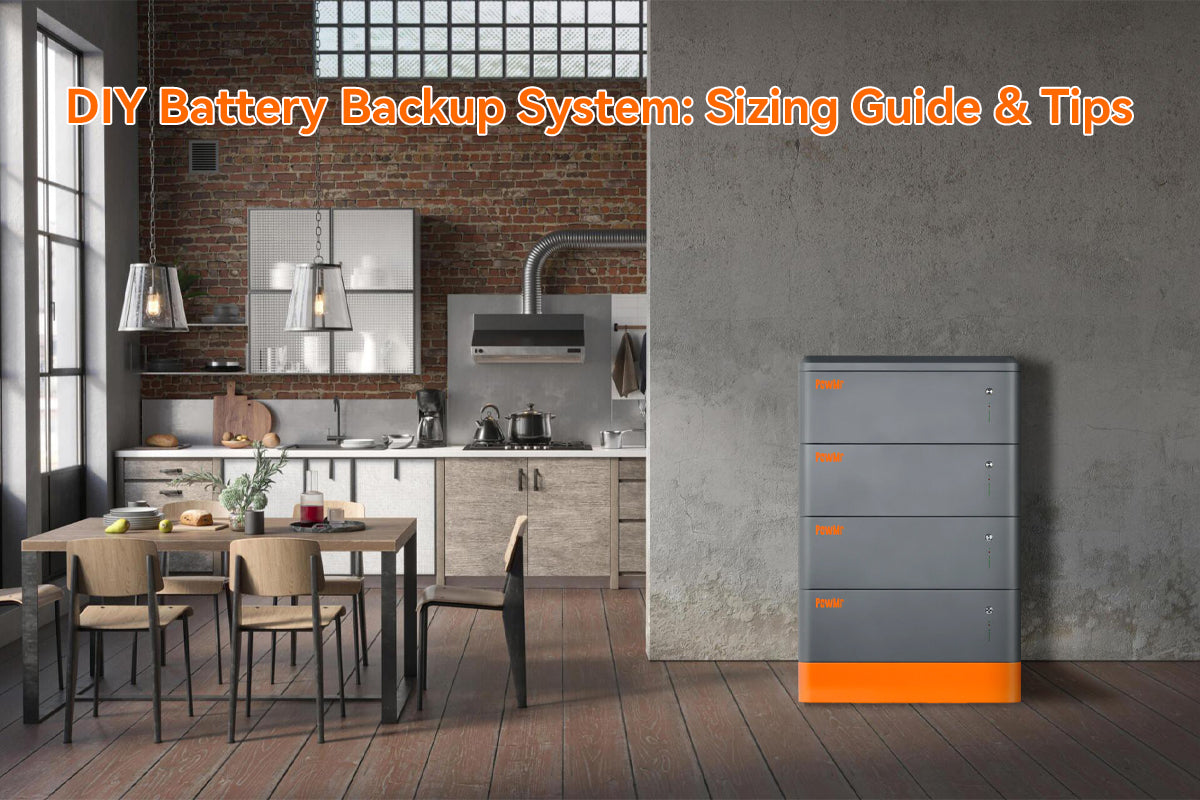ในบล็อกโพสต์ล่าสุด เราได้อธิบายถึง ความหมายและสาเหตุของการโหลดไม่สมดุลในระบบสามเฟส และแนะนำอินเวอร์เตอร์ไฮบริดที่รองรับ การส่งออกที่ไม่สมดุล 100% เพื่อปรับปรุงความยืดหยุ่น ของการกระจายพลังงานในสามเฟส.
ตอนนี้เราจะเปรียบเทียบฟีเจอร์นี้กับอินเวอร์เตอร์สามเฟสที่มีเอาต์พุตสมดุล 100% และพูดคุยเกี่ยวกับวิธีที่อินเวอร์เตอร์ที่มีเอาต์พุตไม่สมดุลสามารถเป็นประโยชน์ต่อคุณได้
เอาต์พุตแบบสมดุล vs เอาต์พุตแบบไม่สมดุล, ความแตกต่างคืออะไร?
อินเวอร์เตอร์เอาต์พุตสมดุลคืออะไร?
สำหรับอินเวอร์เตอร์สามเฟส การส่งออกที่สมดุลหมายความว่าพลังงานที่กระจายโดยอินเวอร์เตอร์ ควรแบ่งอย่างเท่าเทียมกันระหว่างสามเฟส โดยทั่วไปแล้ว ความไม่สมดุลของพลังงานหรือกระแสระหว่างเฟสใด ๆ สองเฟสควรต่ำกว่า 1% โดยมีความทนทานสูงสุดที่ 5%.
เอาต์พุตที่ไม่สมดุลคืออะไร?
ในบริบทของการผลิตไฟฟ้าที่ไม่สมดุลในอินเวอร์เตอร์สามเฟส มี ระดับความไม่สมดุลที่ยอมรับได้มากขึ้น ตัวอย่างเช่น ในสถานการณ์ที่มี การผลิตไฟฟ้าที่ไม่สมดุล 100% ในอินเวอร์เตอร์สามเฟส การใช้โหลดสามารถอยู่ในช่วง 0 ถึง 1/3 ของกำลังไฟฟ้าร rated ในแต่ละเฟส เช่นเดียวกัน หากความไม่สมดุลอยู่ที่ 110% ความแตกต่างของพลังงานระหว่างเฟสใด ๆ สองเฟสจะอยู่ในช่วง 0 ถึง 11/30 ของกำลังไฟฟ้าร rated.
ฟีเจอร์นี้ ซึ่งช่วยให้ การส่งออกพลังงานที่แตกต่างกัน ขึ้นอยู่กับการใช้โหลดของแต่ละเฟส จะ เพิ่มความยืดหยุ่นในการกระจายพลังงาน ในระบบสามเฟสอย่างมาก เมื่อรวมกับพลังงานแสงอาทิตย์ จะช่วยลดการพึ่งพาเครือข่ายไฟฟ้า ทำให้ประหยัดค่าไฟฟ้าได้สูงสุด.
ตอนนี้ มาสำรวจว่าการผลิตที่ไม่สมดุลสามารถเป็นประโยชน์ต่อคุณได้อย่างไร ภายใต้กฎการเรียกเก็บเงินไฟฟ้าที่เฉพาะเจาะจง.
ประโยชน์ของการส่งออกที่ไม่สมดุล
ในการบรรยายต่อไปนี้ เราจะเปรียบเทียบ PowMr ซีรีส์ Solxpow อินเวอร์เตอร์สามเฟสที่มีเอาต์พุตไม่สมดุล กับอินเวอร์เตอร์สามเฟสที่มีเอาต์พุตสมดุลแบบดั้งเดิม.
Solxpow เป็นอินเวอร์เตอร์ที่รองรับการส่งออกที่ไม่สมดุล 100%/110% (ขึ้นอยู่กับรุ่น) มาพร้อมกับมิเตอร์อัจฉริยะที่มี CT ซึ่งสามารถตรวจสอบการใช้พลังงานแบบเรียลไทม์สำหรับแต่ละเฟสและทำการปรับเปลี่ยนตามนั้นได้.
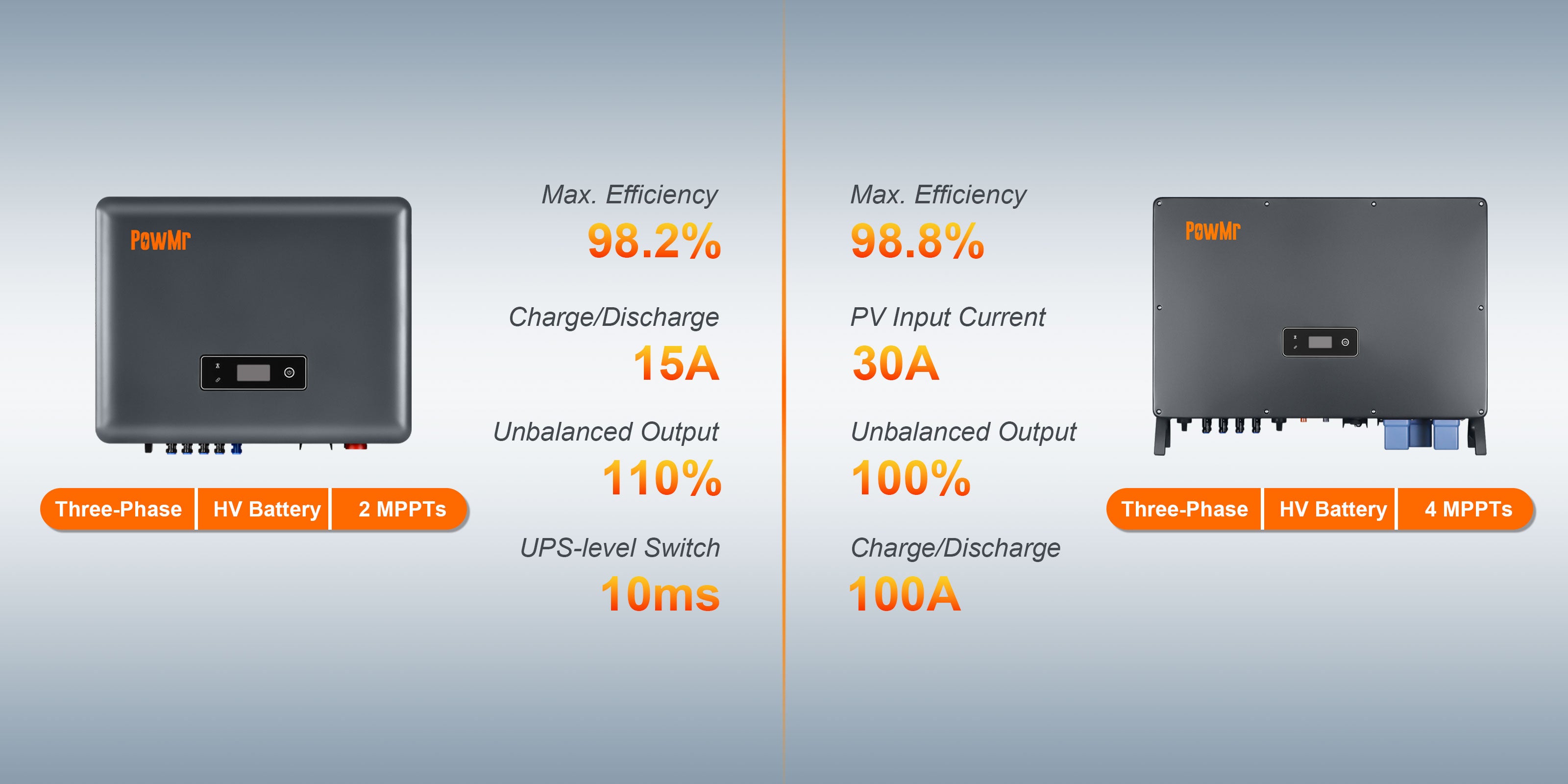
ประหยัดค่าไฟฟ้าเมื่อชาร์จตามเฟส (กริดไท)
สำหรับผู้ใช้ในพื้นที่ ที่ไม่มีการวัดมิเตอร์สุทธิหรืออัตราค่าบริการไฟฟ้า หรือสำหรับผู้ที่มีมิเตอร์พลังงานที่ไม่สามารถปรับสมดุลการซื้อ/ขายพลังงานได้ ความสำคัญของการเพิ่มประสิทธิภาพการผลิตไฟฟ้าแบบสามเฟสที่ไม่สมดุลจึงมีความสำคัญอย่างยิ่ง.
สมมติว่ากำลังไฟที่ระบุของทั้งแผงโซลาร์เซลล์และอินเวอร์เตอร์คือ 15kw และอินเวอร์เตอร์เชื่อมต่อกับ แบตเตอรี่ 3kw สำหรับการชาร์จและการปล่อยพลังงาน โดยให้ความสำคัญในการกระจายพลังงานเป็น โหลด > แบตเตอรี่ > กริด.
อินเวอร์เตอร์สามเฟสแบบบาลานซ์เอาต์พุต
อินเวอร์เตอร์ที่มีการกระจายพลังงานอย่างสมดุลจะกระจายพลังงานอย่างเท่าเทียมกันระหว่างเฟส เฟสที่มี โหลดต่ำสุด จะกำหนดพลังงานที่ส่งออกสำหรับแต่ละเฟส โดยที่อีก สองเฟสจะดึงพลังงานจากกริด เมื่อแบตเตอรี่เต็มแล้ว และจะส่งพลังงานแสงอาทิตย์ส่วนเกินกลับเข้าสู่กริด.

อินเวอร์เตอร์สามเฟสที่ไม่สมดุล
อินเวอร์เตอร์ที่ไม่สมดุลจะจัดสรรพลังงานแสงอาทิตย์ ตามภาระโหลดจริง แทนที่จะแลกเปลี่ยนกับกริด พลังงานส่วนเกินจะถูกเก็บไว้ในแบตเตอรี่หลังจากตอบสนองความต้องการโหลด ซึ่งช่วยเพิ่มอัตราการ บริโภคพลังงานแสงอาทิตย์ด้วยตนเองก่อน ที่จะส่งพลังงานส่วนเกินเข้าสู่กริดอย่างมีนัยสำคัญ.
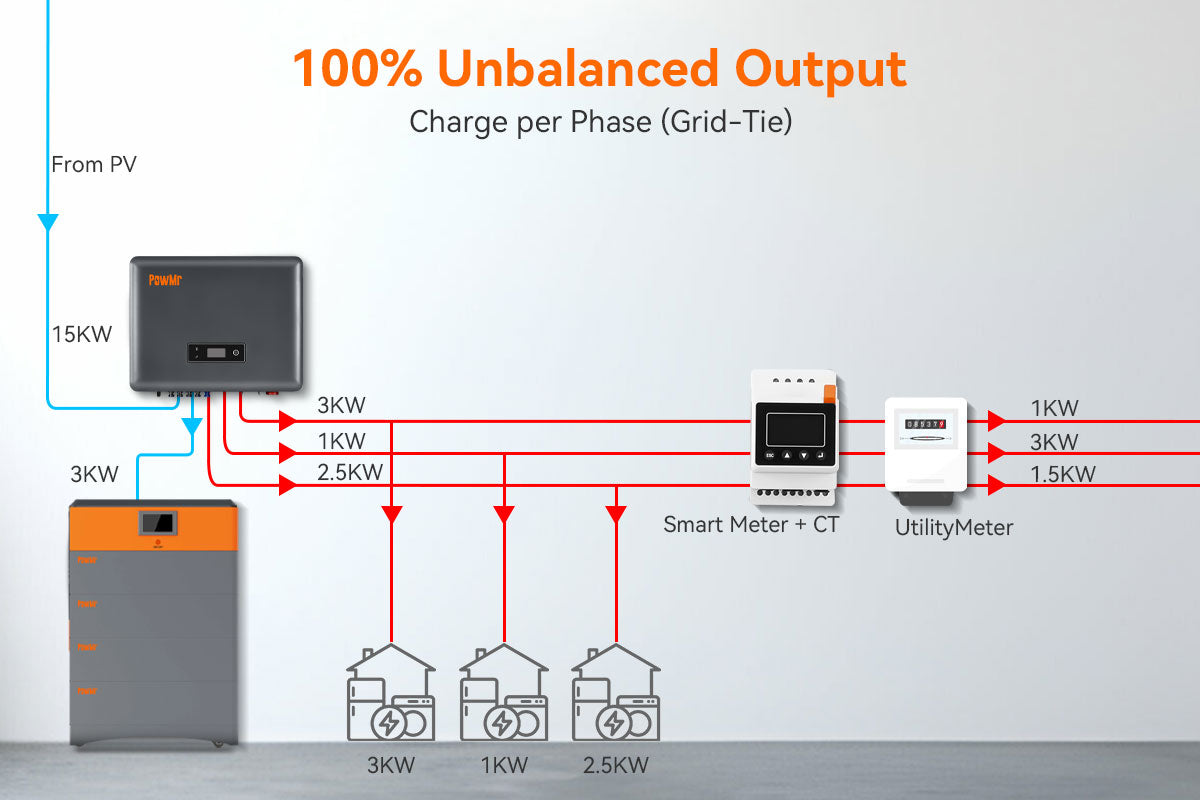
ตามที่แสดงในตารางด้านล่าง โดยมีโหลด 3kW, 1kW และ 2.5kW สำหรับ L1, L2 และ L3 ตามลำดับ ผลรวมของเอาต์พุตสำหรับอินเวอร์เตอร์ที่มีเอาต์พุตสมดุลคือ 3kW ในขณะที่สำหรับอินเวอร์เตอร์ที่มีเอาต์พุตไม่สมดุล โหลดรวมคือ 6.5kW เมื่อพิจารณาถึงพลังงานที่เก็บในแบตเตอรี่ อัตราการใช้พลังงานจากโซลาร์ของระบบเอาต์พุตไม่สมดุลนั้นสูงกว่าระบบเอาต์พุตสมดุลอย่างมาก.

หากบริษัทสาธารณูปโภคของคุณ เรียกเก็บค่าบริการตามการใช้พลังงานของแต่ละเฟส บิลค่าไฟฟ้าสำหรับระบบสามเฟสที่มีการผลิตที่สมดุล 100% จะสูงมาก แม้จะมี FIT อยู่ ก็อาจไม่สามารถชดเชยค่าใช้จ่ายที่สูงได้ หากไม่มี FIT คุณจะต้องแบกรับภาระนี้อย่างเงียบๆ.
ในทางตรงกันข้าม ระบบเอาต์พุตที่ไม่สมดุลสามารถบรรลุความพอเพียงและอาจสร้างรายได้ให้กับคุณได้
เพิ่มการใช้พลังงานแสงอาทิตย์ในระบบที่ไม่มีการส่งออกให้สูงสุด
Solxpow ที่มาพร้อมกับ Smart Meter และ CT ช่วยให้สามารถตรวจสอบการใช้พลังงานของแต่ละเฟสแบบเรียลไทม์และ ควบคุมพลังงานที่ส่งออกได้อย่างแม่นยำ ในตัวอย่างที่ให้ไว้ พลังงานที่ส่งออกถูกจำกัดไว้ที่ 0W.
เรานำสถานการณ์การจำกัดพลังงานส่งออกเป็นตัวอย่าง เนื่องจากข้อจำกัดในการส่งออก นี่จึงหมายถึงการลดลงอย่างมีนัยสำคัญในผลผลิตของแผงโซลาร์เซลล์ ดังนั้นในพื้นที่ที่มีข้อจำกัดในการส่งออก เมื่อออกแบบระบบพลังงานแสงอาทิตย์ พลังงานรวมของแผงโซลาร์เซลล์ควรอยู่ ให้ใกล้เคียงที่สุด กับพลังงานที่ระบุของอินเวอร์เตอร์.
สมมติว่ากำลังไฟที่ระบุของแผงโซลาร์เซลล์และอินเวอร์เตอร์คือ 10 kW และมีแบตเตอรี่ที่มีพลังงานในการชาร์จและการปล่อยพลังงาน 3 kW เชื่อมต่ออยู่ อินเวอร์เตอร์จะให้ความสำคัญในการกระจายพลังงานดังนี้: โหลด > แบตเตอรี่ > กริด โหลดในเฟส L1, L2 และ L3 คือ 3kW, 1kW, และ 2.5kW ตามลำดับ.
ในอินเวอร์เตอร์สามเฟสที่มีการส่งออกที่สมดุล:
การกระจายพลังงานยังคงเป็นธรรม โดยผลผลิตของแต่ละเฟสจะถูกกำหนดโดยเฟสที่มีโหลดพลังงานต่ำที่สุด เฟสอีกสองเฟสจะดึงพลังงานจากกริด เมื่อแบตเตอรี่ชาร์จเต็มแล้ว ด้าน PV จะส่งออก พลังงาน 3 เท่าของเฟสที่มีการใช้พลังงานต่ำที่สุด เท่านั้น.
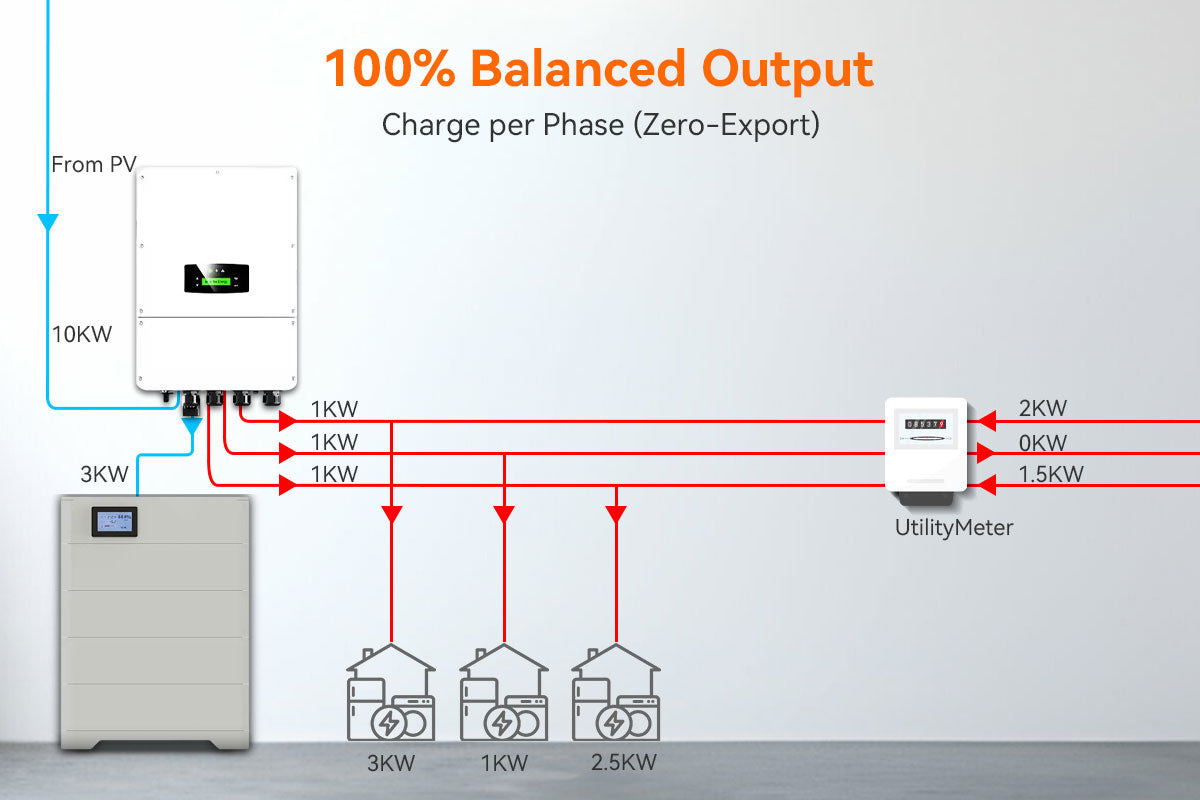
อินเวอร์เตอร์สามเฟสที่ไม่สมดุล
แทนที่จะแลกเปลี่ยนพลังงานกับกริด มันจะกระจายพลังงานแสงอาทิตย์อย่างต่อเนื่องตามความต้องการพลังงานจริงในแต่ละเฟส เพื่อให้แน่ใจว่าความต้องการโหลดได้รับการตอบสนองในขณะที่ชาร์จแบตเตอรี่ไปพร้อมกัน.
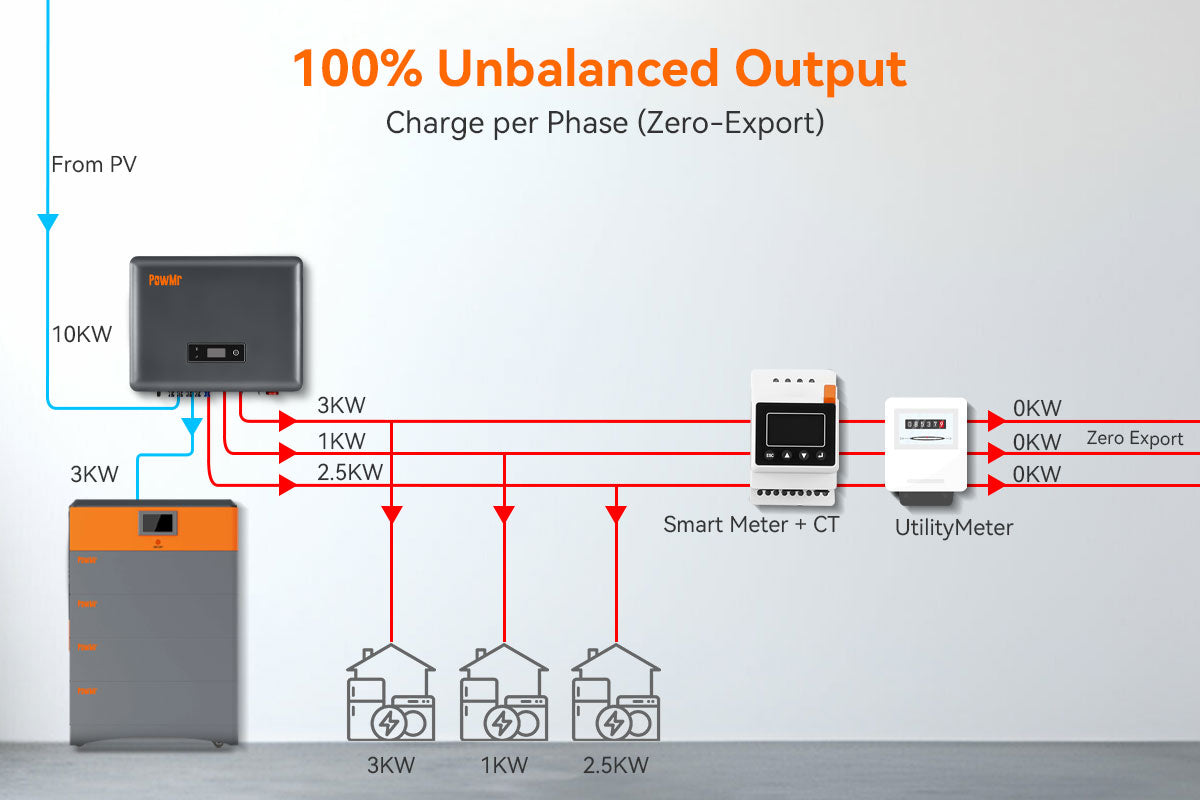
ตามที่แสดงในตารางด้านล่าง ในระบบเอาต์พุตที่สมดุล อินเวอร์เตอร์จะจ่ายพลังงานเพียง 3kW ให้กับโหลดและดึง 3.5 kW จากกริด ในทางตรงกันข้าม อินเวอร์เตอร์ที่มีเอาต์พุตไม่สมดุลจะดึงพลังงาน 6.5 kW จากแผงโซลาร์เซลล์ ทำให้มีความพอเพียงในตัวเอง.
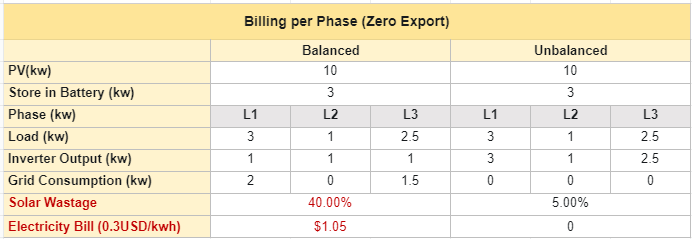
เมื่อพิจารณาถึงพลังงานที่เก็บไว้ในแบตเตอรี่ ระบบเอาต์พุตที่สมดุลใช้พลังงานจากแสงอาทิตย์เพียง 60% เท่านั้น ทำให้ผู้ใช้ยังคงต้องจ่ายค่าไฟฟ้าสูง ในทางกลับกัน อัตราการใช้พลังงานของอินเวอร์เตอร์เอาต์พุตที่สมดุลสูงถึง 95% ซึ่งช่วยลดความจำเป็นในการดึงพลังงานจากกริด
บทสรุป
หากคุณไม่ส่งไฟฟ้าเข้าสู่กริดและสามารถ รักษาโหลดพลังงานให้เท่ากันในแต่ละเฟส ในระบบสามเฟสได้ คุณสามารถเลือกใช้อินเวอร์เตอร์ที่มีเอาต์พุตสมดุลได้
อย่างไรก็ตาม หากคุณ ให้ความสำคัญกับความยืดหยุ่น ในการกระจายพลังงาน โดยเฉพาะเมื่อใช้ทั้งอุปกรณ์แบบเฟสเดียวและแบบสามเฟสภายในระบบ อินเวอร์เตอร์ที่มีการส่งออกไม่สมดุลจึงกลายเป็นตัวเลือกที่ต้องการ นี่เป็นเพราะสามเหตุผลหลัก:
- ในสถานการณ์ ที่ไม่มีการเรียกเก็บเงินจากเครือข่าย การลดการพึ่งพาเครือข่ายเป็นสิ่งสำคัญเพื่อช่วยลดค่าใช้จ่ายไฟฟ้า.
- การมุ่งหวังที่จะใช้พลังงานเองหรือ การเพิ่มผลตอบแทนจากโครงการ FIT จำเป็นต้องมีการใช้พลังงานแสงอาทิตย์อย่างมีประสิทธิภาพและลดการพึ่งพาเครือข่ายไฟฟ้า.
- การเผชิญกับ การส่งออกที่จำกัด หรือความต้องการในการเพิ่มประสิทธิภาพการใช้พลังงานแสงอาทิตย์ในขณะที่ ลดการพึ่งพาเครือข่าย และ ประหยัดค่าไฟฟ้า ยิ่งเน้นย้ำถึงประโยชน์ของการเลือกใช้อินเวอร์เตอร์ที่มีการส่งออกที่ไม่สมดุล.

